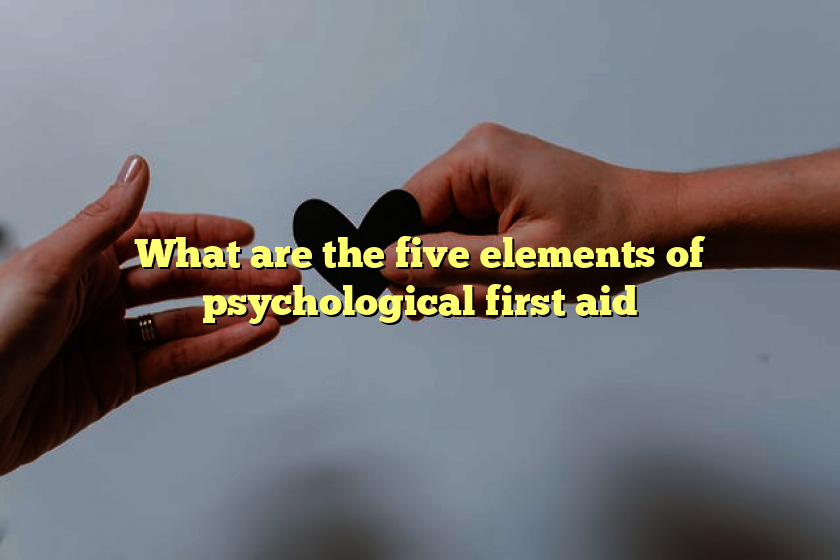 Photo by Jared Steinman
Photo by Jared Steinman
The common image of a first responder is someone with a snappy set of gloves smoothly bandaging a spurting wound or administering an EpiPen to a patient having an anaphylactic reaction. Injuries, we imagine, are easy to see and easy to fix.
While treating physical wounds seems like the most important way a first responder can help a patient, there’s a lot that we can do to care for a patient’s mental health, especially during and right after a traumatic event.
Psychological First Aid is a set of tools NOLS Wilderness Medicine has integrated into our curriculum to help patients as they respond to traumatic events. Tod Schimelpfenig, NOLS Wilderness Medicine’s curriculum director, writes, “We understand that treating the emotional impact from responding to or experiencing stressful events is as important as the physical first aid we practice.”
To help you better manage and prevent stress injuries, like post-traumatic stress, here are five of the tools we teach in our Wilderness First Responder and Wilderness EMT courses.
The 5 Components of Psychological First Aid
1. Create a Sense of Safety
Creating a sense of safety means you communicate to the brain’s fight or flight system that the stressful situation is over. You can do that by shielding the patient from a disturbing scene or explaining to the individual that they’re safe. Reinforce this by showing them what you’ve done to make the scene safe, like moving them away from a precarious edge or pointing out that the thunderstorm has passed and the weather has calmed.
2. Create Calm
This is important both before and while responding. Speaking and acting calmly can show your patient they’re in a safe place and can start calming themselves. If you’re struggling to calm yourself or your patient, use simple tools like taking a deep breath, counting to four, then letting your breath out slowly, and coaching your patient to do the same. It’s hard to calm someone else when you don’t feel calm yourself, so check your own composure before helping your patient.
3. Create Self and Collective Efficacy
Efficacy is your ability to produce a desired result. You can help your patient foster self-efficacy by making them an active part of their own rescue. Remind your patient of their existing strengths, allow them to care for themselves or help their companions, and involve them in decisions about their care. This helps them overcome the feeling of helplessness that sometimes comes with a traumatic event. They’re no longer a victim, but a part of the team.
4. Create Connection
Creating connection helps the patient tap into the social supports that surround them. You can create connection by building an on-scene relationship with your patient: use their name and build a rescue partnership. This also includes connecting the patient with loved ones or even pets.
5. Create Hope
Hope in this context means the belief that, although the current situation may be grim, it can get better. To build hope, point to specific, accurate, and positive facts about the event, and discuss next steps that are realistic and predictable. Maintaining hope is as important for the individual patient as it is for your team as you provide care.
These tools, while not professional mental health interventions, are based on the latest mental health research and are available for anyone to use. Many individuals find these tools so powerful that they shine a light on their own experiences of stress.
Safety. Calming. Self-efficacy. Connection. Hope. Pack them in your remote medicine kit—you won’t regret it.
Treatment Principles for Psychological First Aid

Editor’s note: Reading about these principles is only the first step to giving effective psychological first aid. We encourage you to get appropriate training, which you can learn as a part of a NOLS Wilderness Medicine course.
This post was adapted from the Spring 2017 issue of The Leader under the title “Psychological First Aid Toolkit—What’s in Yours?”
Nicole Sadler: Psychological First Aid (PFA) is based on principles that have been drawn from years of research, field experience, and expert consensus on how best to support people after exposure to a trauma. A wide variety of people with basic training and interpersonal skills can deliver PFA. It’s not formal assessment or a therapy process, and it is also not pressuring people to tell you about their feelings or reactions to an event. PFA aims to do no harm and to provide practical and emotional support that is aligned with the needs and preferences of the individual, as well as their cultural and spiritual backgrounds. PFA sits within a stepped care approach as a low level intervention. Stepped care is an evidence-based and widely used public health approach that recognises that the level of mental health support should be matched to the individual’s needs. Therefore, when providing PFA, you may identify that the individual needs to be stepped up into the next level of mental health support, and so you link them with a GP or a specialist mental health service.
There are five key principles of PFA: a sense of safety, calming, a sense of self and community efficacy, connectedness, and hope. When providing PFA, it’s important to keep each of these principles in mind.
As a PFA provider, you should firstly aim to reintroduce a sense of safety, as this has been shown to reduce negative reactions over time. Safety here refers to both physical and psychological safety. Psychological safety refers to protecting people from situations that may cause them further distress, such as seeing terrible things on the news or in person, receiving bad news in an insensitive or uncontrolled way, or even being approached by the media. In some settings, promoting safety will involve helping people put in place their own strategies to prevent further exposure to these stressors. As a PFA provider, you may also support their physical safety by guiding them away from any ongoing threat and helping them meet basic needs such as accessing water, food, and shelter, or helping them obtain emergency medical attention.
Secondly, we’re aiming to promote calm, as we know it is normal for people to experience a wide range of strong emotions after a trauma. This principle refers to helping people cope with strong emotions, as well as creating a calm environment for the impacted person, workplace or community. For example, you may use simple psychological strategies such as controlled breathing to help individuals cope better with any strong emotional reactions. Further, calming may involve creating a sense of order and organisation in crisis settings, such as creating quiet spaces for highly distressed people, or safe areas for children separated from their loved ones.
Thirdly, we seek to promote a sense of self and community efficacy. This is about helping people to have a sense of control over positive outcomes by encouraging people to see a link between the actions they take, either as an individual or as a community, and positive outcomes. This principle highlights that people, teams and communities bring with them many existing strengths and resources, and they are best placed to determine what is best for their situation. It may be simply a matter of reminding people of their own abilities, or you might help them to determine and access what resources they may be missing so that they can take positive actions to support their own recovery.
The fourth principle is connectedness, which is critical to recovery from trauma. Social connections help people to solve practical problems through information sharing and helping with daily tasks, as well as to gain emotional understanding and acceptance of what has happened. As a PFA provider, you might support connection by ensuring families are kept together, helping people contact loved ones, or linking them with relevant services.
And finally, instilling hope. Most of us are unprepared for a very traumatic event and it can lead to people no longer seeing the world as a safe or predictable place as they did before the trauma. This can lead to a sense of hopelessness, and people can even give up trying. As a PFA provider, we can help instil hope by helping individuals to understand that their reactions are common, and conveying an expectation that people can recover from trauma, and you can support people to take one step at a time and to notice small gains so that they can begin to look forward.
Using these five PFA principles will look different in every situation, but as an example, if you were asked to support a distressed team member after a critical incident, you might apply the principles by guiding them away from the media to a calm and private environment. After helping them calm their breathing and reassuring them that their reactions are normal, you ask them what they need right now. They say they want to call a loved one and figure out a way to finish their shift and get home safely. You help them do both these things and ask if it’s OK for you to check in with them the next day.
When you learn how to apply these PFA principles, you’ll be able to provide the most effective response to people who need your help whilst also taking care of yourself.




